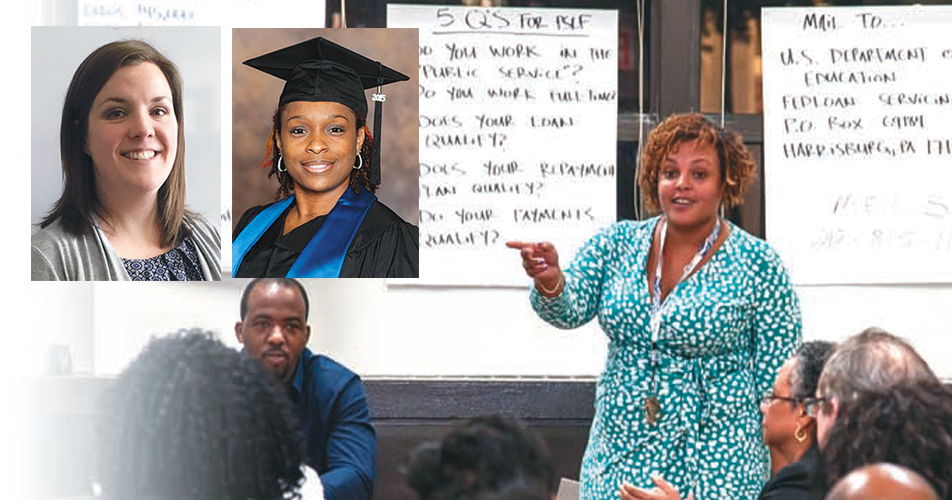
New York DC37 members attend a workshop on debt management and relief programs.
The evidence of a student loan crisis is in the numbers. Americans owe a whopping $1.3 trillion in student loans. For comparison, that’s equal to the total value of all currency circulating in the United States right now.
With many AFSCME members among those facing this massive debt, our union is seeking to help people by spreading the word about programs like Public Service Loan Forgiveness and by advocating for more sensible education policies. The fact is it’s not just young people facing this deficit as they begin their careers, mid-career and even retirees are increasingly feeling its effects.
Taking Debt into Retirement
There are 2.2 million people in the United States over the age of 60 who hold student loan debt. According to the Government Accountability Office, the average borrower in this demographic owes $19,521.
That money has to be paid back one way or another, and for a rising number of seniors that means painful costs. In 2013, about 160,000 seniors had their Social Security checks garnished because of student loan defaults. That number has tripled since the start of the recession.
Some of these retirees have taken out loans for their children’s education, but 80 percent borrowed to cover their own educational expenses.
The situation is a glimpse into the squeeze that middle-class Americans are facing from all sides. Today, workers are trying to pay down debts during the years that they otherwise might spend building their retirement nest eggs.

Yvette Silas
“I will be paying for this till I’m old and gray,” says Yvette Silas, a school health aide with Local 44 (Council 67) in Maryland. She has been working in the health field for 15 years, but recently decided to return to school for a masters in administration so that she can move forward in her career. “Public workers are working so hard just to cover the basics. After those day-to-day costs, what’s left over for the big expenses?”
Jobs that offer strong retirement benefits and pensions are hard to come by these days. As a result, many Americans must count on their individual savings and Social Security benefits to last through retirement. But when you’re already struggling to make your loan payments and your $1,200 monthly Social Security check can be garnished by hundreds of dollars a month, how do we get to real retirement security?
Planning for the Future in a World of Debt
People under the age of 30 are less likely to be saving for retirement, and are less likely to be saving at recommended rates, than young people in earlier generations. In fact, the median millennial worker has no retirement savings at all. It’s tough to set aside money for savings while the interest on your loan ticks higher and higher every month.
That’s certainly the case for Kristen Corey, a member of Local 3450 (Council 61) in Iowa. Since she and her husband are already struggling to balance the day-to-day costs of child care with their student debt, saving for the future is tough. “We recently had a second child, and honestly, we have no idea what we're going to do to save up for retirement and save up for college for them,” she says. “They will potentially be in the same situation that we're finding ourselves in now.”
How Our Union Is Helping

Kristen Corey
If we want to protect retirement, we can’t forget about student debt. We need more affordable education, more sensible lending practices, and more robust retirement options for all Americans.
District Council 37 in New York City is hard at work to make sure every AFSCME member is up-to-date when it comes to the student debt issue. Partnered with the nonprofit group Jobs with Justice and AFSCME Next Wave, DC 37 is hosting workshops where members can learn how to enroll in debt management and relief programs.
They’re also making student debt activism a part of the larger AFSCME Strong program that’s strengthening our union. When members talk to their co-workers about union power, they’re also talking about the debt forgiveness options that are available for public service workers.
In Ohio, union members are making dramatic strides toward a more accessible educational system. The Ohio Civil Service Employees Association (OCSEA) and Council 8 partnered with the Eastern Gateway Community College system to provide free education to members and their families. All OCSEA and Council 8 members, and their spouses, children and grandchildren, can get their two-year associate’s degree for free simply by completing a financial aid application. The program is just starting now, but hundreds of working families have already applied. You can find more information at ocseaeducation.org. You can also visit afscmecouncil8.org/scholarship-opportunities.
Nationwide, AFSCME is advocating for policy solutions and working to ensure that all public service workers have the resources and information they need in order to manage their student debt. You may be eligible for federal debt forgiveness or refinancing. Learn how your union can help by going to AFSCME.org/student-debt.
